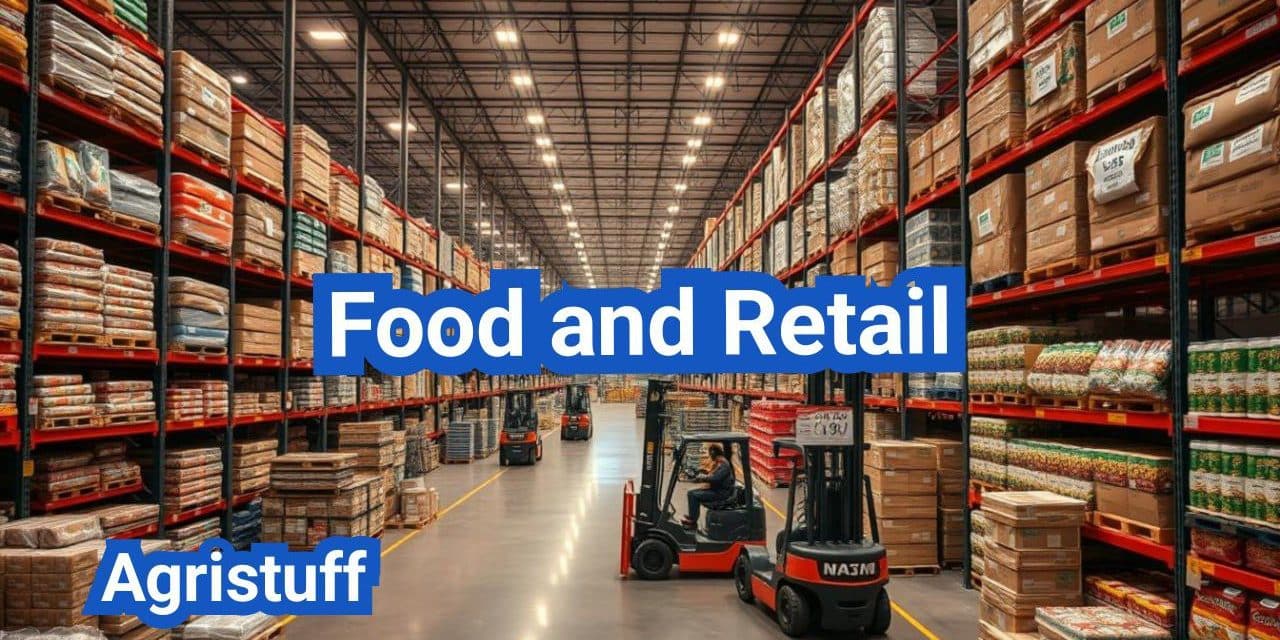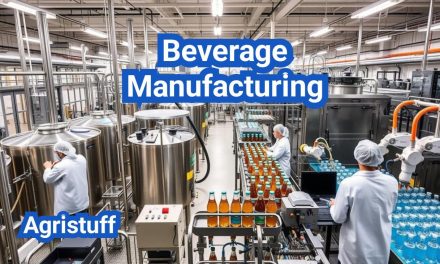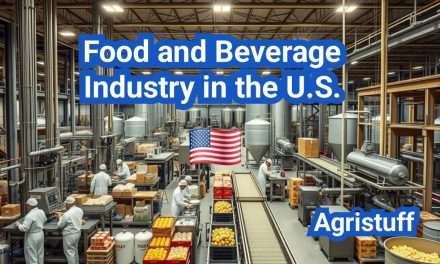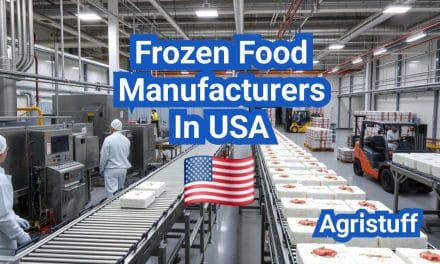The U.S. grocery retail supply chain is a complex network involving various stakeholders, including manufacturers, wholesalers, and retailers. Effective collaboration between these entities is crucial for ensuring that products reach consumers efficiently.
U.S. manufacturers work closely with grocers and big-box stores to streamline their operations, from production to delivery. This partnership enables companies to respond to changing consumer demands and stay competitive in a rapidly evolving market.
Key Takeaways
- The U.S. grocery retail supply chain involves multiple stakeholders.
- Collaboration is key to efficient product delivery.
- Manufacturers work closely with grocers and big-box stores.
- Streamlined operations help companies respond to consumer demands.
- Partnerships enable businesses to stay competitive.
The U.S. Food and Retail Landscape
The U.S. food and retail industry is a multifaceted market with various stakeholders. It encompasses a wide range of businesses, from grocery stores to big-box retailers, that play crucial roles in the supply chain.
The market size of the U.S. food retail sector is substantial, with sales figures consistently trending upward. According to recent data, the retail food sales have seen steady growth, driven by consumer demand and changes in shopping habits.
Current Market Size and Growth Trends
The U.S. food retail market has experienced significant growth in recent years, driven by factors such as population growth, changes in consumer preferences, and the rise of online shopping. The total sales in the grocery sector have reached impressive figures, with e-commerce playing an increasingly important role.
Key statistics indicate that the market is expected to continue growing, albeit at a moderate pace. Factors influencing this growth include consumer spending patterns, the competitive landscape, and regulatory environments.
Key Players in Grocery and Big-Box Retail
The U.S. grocery and big-box retail landscape is dominated by a few major players. Companies like Walmart, Target, and Kroger are among the top retailers, with significant market share and influence over the supply chain.
- Walmart: Known for its vast network of stores and e-commerce platform.
- Target: A retail chain offering a range of products, including groceries.
- Kroger: One of the largest grocery store chains in the U.S.
These retailers have a significant impact on the industry, driving trends and setting standards for supply chain management, customer service, and product offerings.
Understanding the Grocery Retail Supply Chain

Understanding the intricacies of the grocery retail supply chain is vital for manufacturers and retailers alike. The supply chain involves a complex network of stakeholders, including manufacturers, wholesalers, distributors, and retailers, all working together to ensure that products reach consumers efficiently.
Supply Chain Structure and Stakeholders
The grocery retail supply chain is structured around several key stakeholders. Manufacturers produce the goods, while wholesalers and distributors play a crucial role in storing and transporting these products to retailers, who ultimately sell them to consumers. Each stakeholder must work in tandem to maintain a smooth and efficient supply chain.
The role of third-party logistics providers (3PLs) has become increasingly important, offering services such as warehousing, transportation, and freight management. This allows retailers and manufacturers to focus on their core competencies while leveraging the expertise of logistics specialists.
Distribution Models for Food Products
There are several distribution models used in the grocery retail supply chain, each with its advantages. The direct store delivery (DSD) model, where manufacturers directly deliver products to retail stores, is common for perishable goods and beverages. In contrast, the centralized distribution model involves shipping products to a central warehouse before they are delivered to stores, which can help reduce costs and improve efficiency.
Some retailers are adopting cross-docking strategies, where products are transferred from one truck to another without being stored in a warehouse, reducing handling costs and speeding up delivery times.
Differences Between Grocery and Big-Box Distribution
Grocery stores and big-box retailers have different distribution needs due to the nature of their products and business models. Grocery stores typically require more frequent deliveries of perishable goods, such as dairy and fresh produce, necessitating a more agile supply chain. In contrast, big-box retailers often deal with a wider range of products, including non-perishable goods and general merchandise, which can be stored for longer periods.
The distribution strategies for these retailers must be tailored to their specific needs, with grocery stores focusing on maintaining product freshness and big-box retailers optimizing for cost and efficiency across a broader product range.
Navigating Retailer Vendor Onboarding Processes
Navigating the complex process of retailer vendor onboarding is crucial for suppliers looking to partner with major grocery retailers. This process involves several key steps that ensure suppliers meet the retailer’s standards for quality, compliance, and operational efficiency.
Initial Qualification Requirements
The initial qualification process typically involves a thorough assessment of the supplier’s capabilities, including their production capacity, quality control measures, and compliance with relevant regulations. Key requirements often include:
- Business registration and tax compliance
- Product liability insurance
- Certifications such as FDA registration or organic certification
- Compliance with food safety standards like FSMA
Suppliers must ensure they meet all these criteria to progress through the onboarding process.
Documentation and Compliance Verification
Once initial qualifications are met, suppliers must provide detailed documentation to verify compliance with the retailer’s specific requirements. This includes:
- Product information and labeling compliance
- Supply chain mapping and traceability
- Quality control and sanitation procedures
- Certifications and audit reports
Compliance verification is a critical step, as it ensures that suppliers adhere to the retailer’s standards and regulatory requirements.
Supplier Portal Registration
After completing the documentation and compliance verification, suppliers are typically required to register on the retailer’s supplier portal. This platform facilitates:
- Order management and fulfillment
- Invoice and payment processing
- Product information management
- Performance monitoring and reporting
Effective use of the supplier portal is crucial for maintaining a smooth and efficient partnership with the retailer.
Essential Compliance Requirements for Food Manufacturers

The food manufacturing industry is subject to various regulatory requirements, including those related to preventive controls, traceability, and transportation sanitation. Ensuring compliance with these regulations is crucial for maintaining product safety and quality, as well as for successful partnerships with major grocery and big-box retailers.
FSMA Preventive Controls
The Food Safety Modernization Act (FSMA) Preventive Controls rule is a critical regulation that requires food manufacturers to implement preventive controls to minimize or prevent hazards in their production processes. This involves developing and implementing a written food safety plan that includes:
- Identifying potential hazards that require preventive controls
- Implementing preventive controls to manage these hazards
- Monitoring the effectiveness of these controls
- Correcting any issues that arise
- Verifying that the preventive controls are effective
Preventive controls can include process controls, such as temperature controls during processing, and sanitation controls to prevent contamination. Manufacturers must also maintain detailed records of their preventive controls and their implementation.
Food Traceability Rule Implementation
The FSMA Food Traceability Rule is designed to enhance the FDA’s ability to rapidly identify and remove contaminated food from the market, thereby reducing the risk of foodborne illnesses. To comply, food manufacturers must maintain detailed records of their products, including information about the sources of their ingredients, production details, and distribution records.
Key components of the rule include:
- Maintaining traceability records for critical tracking events, such as harvesting, processing, and shipping
- Implementing systems to quickly identify recipients of their products
- Providing required information to regulatory bodies upon request
Sanitary Transportation Requirements
The Sanitary Transportation Rule under FSMA aims to prevent practices that could lead to contamination or adulteration of food during transportation. Food manufacturers must ensure that their transportation practices meet specific sanitary standards, including:
- Ensuring vehicles and equipment are properly cleaned and sanitized
- Maintaining appropriate temperature controls during transport
- Implementing procedures to prevent cross-contamination
By adhering to these sanitary transportation requirements, manufacturers can reduce the risk of contamination and ensure compliance with FDA regulations.
Product Identification and Barcoding Standards
In the U.S. food and retail industry, product identification and barcoding standards play a vital role in supply chain efficiency. Accurate and standardized product identification enables manufacturers, suppliers, and retailers to efficiently track and manage products throughout the supply chain.
GS1 Barcode and GTIN Implementation
The GS1 system is the global standard for product identification, providing a unique identifier for each product through Global Trade Item Numbers (GTINs). Implementing GS1 barcodes and GTINs is crucial for:
- Ensuring accurate product tracking and inventory management
- Facilitating efficient checkout processes
- Enabling precise order fulfillment and shipping
GTIN implementation involves assigning a unique identifier to each product variant, including different sizes, flavors, and packaging configurations. Manufacturers must ensure that GTINs are correctly encoded in barcodes and accurately represented in product data feeds.
Product Data Management Best Practices
Effective product data management is critical for maintaining accurate product information across the supply chain. Best practices include:
- Maintaining a centralized product data repository
- Ensuring data accuracy and consistency across all platforms
- Regularly updating product information to reflect changes in product formulations, packaging, or pricing
Data synchronization is key to ensuring that product information is consistent across all trading partners. Manufacturers should utilize data synchronization platforms to maintain up-to-date product information.
Big-Box Retailer-Specific Requirements
Major retailers often have specific requirements for product identification and barcoding. For example:
| Retailer | Specific Requirements |
|---|---|
| Walmart | Requires GS1-certified GTINs and specific barcode placement on packaging |
| Target | Mandates the use of GS1 barcodes and compliance with their vendor onboarding process |
Manufacturers must familiarize themselves with the specific requirements of each major retailer they partner with to ensure compliance and avoid potential penalties or delays in product listing.
Food Labeling Requirements for Retail Distribution

Food manufacturers must adhere to stringent labeling requirements to distribute their products in retail channels. Accurate and compliant labeling is not only a regulatory necessity but also crucial for building consumer trust.
Nutrition Facts Labeling Compliance
The Nutrition Facts label is a critical component of food packaging, providing consumers with essential information about the nutritional content of the product. To comply with FDA regulations, manufacturers must ensure that their labels include:
- Nutritional information such as calories, total fat, sodium, and total carbohydrates.
- Serving size and servings per container.
- % Daily Value (DV) for various nutrients.
Manufacturers must also comply with the FDA’s serving size requirements and ensure that their labeling reflects the actual consumption of their products.
Allergen Labeling Regulations
Allergen labeling is a critical aspect of food safety. The FDA requires that food labels clearly identify the presence of major food allergens, which include:
- Milk
- Eggs
- Fish
- Crustacean shellfish
- Nuts
- Wheat
- Soybeans
- Sesame
Manufacturers must declare these allergens on the label using plain language, making it easier for consumers with allergies to make informed decisions.
Marketing Claims and Regulatory Oversight
Marketing claims on food labels are subject to regulatory oversight to prevent misleading or deceptive labeling. The FDA and FTC regulate claims related to:
- Health claims: Claims that a food product can prevent or treat a disease.
- Nutrient content claims: Claims that a product is high or low in a particular nutrient.
- Structure/function claims: Claims that a product maintains or supports a body function.
Manufacturers must ensure that their marketing claims are substantiated by scientific evidence and comply with FDA guidelines to avoid regulatory action.
Mastering Category Management in Grocery Retail

Mastering category management is essential for grocery retailers to drive sales and profitability. Category management involves managing a group of products as a single unit to satisfy consumer needs. It requires a strategic approach to defining and positioning categories, collaborative planning, and measuring performance.
Category Definition and Positioning
Category definition and positioning are critical components of category management. Category definition involves identifying and grouping products that meet similar consumer needs. For instance, a grocery retailer might define a category for organic produce or another for gluten-free products. Category positioning refers to how these categories are presented to consumers, influencing their shopping experience and purchasing decisions.
To effectively define and position categories, grocery retailers must understand consumer behavior and preferences. This involves analyzing sales data, consumer feedback, and market trends.
Collaborative Category Planning
Collaborative category planning is a joint effort between retailers and suppliers to develop strategies that drive category sales and profitability. This collaborative approach ensures that both parties are aligned in their goals and objectives, leading to more effective category management.
Key elements of collaborative category planning include:
- Joint business planning
- Category scorecards
- Regular review meetings
Performance Metrics and KPIs
To measure the success of category management strategies, grocery retailers must track relevant performance metrics and KPIs. These may include sales growth, market share, and category profitability.
| Metric | Description | Target |
|---|---|---|
| Sales Growth | Increase in category sales over a specified period | 5% quarterly |
| Market Share | Category’s share of the total market | 15% |
| Category Profitability | Profit generated by the category | $1 million annually |
By mastering category management, grocery retailers can improve their competitiveness and drive business growth.
Developing Private Label Partnerships with Retailers

The growth of private label products is transforming the retail landscape, offering new opportunities for manufacturers.
Private label products have gained significant traction in recent years, driven by consumer demand for affordable, high-quality alternatives to national brands. This shift presents both opportunities and challenges for manufacturers looking to partner with retailers.
Private Label Market Trends
The private label market is experiencing substantial growth, with sales increasing by 8.4% annually in the United States. This trend is driven by several factors, including:
- Changing consumer preferences towards more affordable options
- Retailers’ efforts to improve profit margins
- Increased focus on quality and sustainability
To capitalize on this trend, manufacturers must understand the evolving needs of retailers and consumers.
Negotiating Private Label Agreements
Negotiating successful private label agreements requires a deep understanding of the retailer’s needs and the manufacturer’s capabilities. Key considerations include:
| Aspect | Manufacturer Considerations | Retailer Considerations |
|---|---|---|
| Pricing | Cost structure, profit margins | Competitive pricing, profit targets |
| Quality | Production capabilities, quality control | Product specifications, brand standards |
| Supply Chain | Logistics, inventory management | Delivery schedules, inventory levels |
Quality and Consistency Requirements
Maintaining quality and consistency is crucial for private label products. Manufacturers must adhere to strict quality control measures, including:
- Compliance with food safety regulations
- Adherence to product specifications
- Regular quality audits
By understanding market trends, negotiating effective agreements, and ensuring quality and consistency, manufacturers can develop successful private label partnerships with retailers.
Electronic Data Interchange (EDI) for Grocery Suppliers

Grocery suppliers are increasingly relying on Electronic Data Interchange (EDI) to enhance their supply chain efficiency and comply with retailer requirements. EDI enables the electronic exchange of business documents between suppliers and retailers, streamlining transactions and improving accuracy.
Common EDI Transaction Sets
EDI involves various transaction sets that cater to different business needs. For grocery suppliers, some of the most common EDI transaction sets include:
- Purchase Order (850): Used by retailers to place orders with suppliers.
- Advance Ship Notice (ASN) (856): Sent by suppliers to inform retailers about upcoming shipments.
- Invoice (810): Used by suppliers to bill retailers for goods shipped.
Implementing these transaction sets correctly is crucial for smooth operations and to avoid delays or penalties.
Advance Ship Notice (ASN) Implementation
The Advance Ship Notice (ASN) is a critical EDI transaction set that allows suppliers to notify retailers about shipments in advance. Proper ASN implementation involves:
- Ensuring accurate data, including product details and shipping information.
- Timely transmission of ASN to the retailer.
- Compliance with the retailer’s ASN requirements, which may vary.
Effective ASN implementation helps retailers prepare for incoming shipments, reducing the risk of delays and improving inventory management.
Technical Integration Considerations
To successfully integrate EDI into their operations, grocery suppliers must consider several technical factors:
| Technical Factor | Description | Importance |
|---|---|---|
| EDI Software | Choosing the right EDI software that supports required transaction sets and integrates with existing systems. | High |
| Data Mapping | Accurately mapping data from internal systems to EDI format. | High |
| Security | Ensuring the security of EDI transactions through encryption and secure protocols. | Critical |
| Testing | Thoroughly testing EDI integrations before going live. | High |
By carefully considering these technical integration factors, grocery suppliers can ensure a smooth and efficient EDI implementation.
Adapting to Omnichannel Food and Retail Strategies

The shift towards omnichannel retailing presents both challenges and opportunities for U.S. food manufacturers. As consumers increasingly expect a seamless shopping experience across online and offline channels, manufacturers must adapt their strategies to meet these evolving demands.
Click and Collect Grocery Requirements
Click and collect grocery services have gained popularity, offering consumers the convenience of ordering online and picking up their groceries at a physical store location. To effectively support click and collect services, food manufacturers must ensure their products are properly packaged and labeled for easy identification. This includes using GS1 barcodes and complying with retailer-specific packaging requirements.
Moreover, manufacturers should be prepared to provide real-time inventory data to ensure that products are available for pickup when customers arrive at the store. This requires integrating with retailers’ inventory management systems and potentially investing in advanced inventory management technologies.
Direct-to-Consumer Shipping Considerations
Direct-to-consumer shipping is another critical aspect of omnichannel retailing. Food manufacturers must consider the unique challenges associated with shipping perishable goods directly to consumers. This includes ensuring that products are properly insulated and packaged to maintain their quality during transit.
Additionally, manufacturers should be aware of the sanitary transportation requirements set forth by the FDA, which mandate that food products be transported in a manner that prevents contamination and maintains their integrity. Compliance with these regulations is crucial to avoid potential fines and reputational damage.
Digital Content Requirements for Online Sales
To succeed in omnichannel retailing, food manufacturers must also focus on creating high-quality digital content that supports their products online. This includes providing accurate product descriptions, high-resolution images, and detailed nutritional information.
Manufacturers should work closely with retailers to ensure that their digital content meets the retailers’ requirements and is optimized for search engines. By doing so, they can improve their products’ visibility online and enhance the overall shopping experience for consumers.
Leveraging Retail Media Networks in Grocery

The rise of retail media networks in grocery retail is revolutionizing how brands connect with consumers through digital advertising platforms. Retail media networks allow grocery retailers to offer targeted advertising solutions, enhancing the shopping experience and providing brands with valuable consumer insights.
In-Store Promotion Opportunities
In-store promotion opportunities are a crucial aspect of retail media networks in grocery. These include:
- Digital signage and displays
- Targeted promotions based on shopper data
- In-store events and demonstrations
By leveraging these opportunities, brands can increase their visibility and engagement with consumers at the point of purchase.
Digital Advertising Platforms
Digital advertising platforms are a key component of retail media networks, enabling brands to reach consumers through various digital channels. These platforms offer:
- Targeted advertising based on consumer behavior
- Real-time performance metrics
- Personalized advertising content
This allows brands to optimize their advertising strategies and improve their return on investment (ROI).
Measuring Promotional ROI
Measuring the ROI of promotional activities is essential for brands to understand the effectiveness of their campaigns. Retail media networks provide:
| Metric | Description | Benefit |
|---|---|---|
| Sales Lift | Increase in sales attributed to the promotional activity | Quantifies the impact of the promotion |
| Engagement Rate | Measure of consumer interaction with the promotion | Indicates consumer interest and participation |
| Conversion Rate | Percentage of consumers who made a purchase after engaging with the promotion | Shows the effectiveness of the promotion in driving sales |
By analyzing these metrics, brands can refine their promotional strategies and maximize their ROI.
Implementing Food Waste Reduction Strategies in Retail
Food waste reduction in retail involves several key strategies, including packaging optimization and collaborative forecasting. Retailers are under increasing pressure to reduce their environmental footprint, and minimizing food waste is a critical component of this effort.
Packaging and Shelf-Life Optimization
One of the primary methods retailers are using to reduce food waste is through packaging and shelf-life optimization. This involves adjusting packaging sizes, materials, and designs to better preserve the freshness of products. For instance, some retailers have introduced smaller packaging options for single-person households, reducing the likelihood of surplus food going to waste.
- Redesigning packaging to improve barrier properties against moisture and oxygen.
- Implementing smart packaging technologies that monitor freshness.
- Adjusting packaging sizes to suit different consumer needs.
Collaborative Forecasting to Reduce Waste
Collaborative forecasting is another critical strategy for reducing food waste. By working closely with suppliers and using advanced data analytics, retailers can improve demand forecasting accuracy. This helps prevent overstocking, which is a significant contributor to food waste.
- Sharing sales data with suppliers to improve forecast accuracy.
- Using machine learning algorithms to predict demand fluctuations.
- Regularly reviewing and adjusting forecasts based on real-time sales data.
Secondary Market and Donation Programs
Retailers are also turning to secondary market and donation programs as a way to reduce waste. Products nearing their expiration dates can be donated to food banks or sold through secondary channels at discounted prices.
- Partnering with food banks and other charitable organizations.
- Creating secondary product lines or discount stores for near-expired products.
- Utilizing online platforms to sell surplus products quickly.
By implementing these strategies, retailers can significantly reduce food waste, enhancing their sustainability credentials and contributing to a more environmentally friendly supply chain.
Mastering Grocery Demand Forecasting

Grocery demand forecasting is a complex process that involves understanding seasonal trends, promotional impacts, and collaborative forecasting techniques. Accurate forecasting enables retailers to optimize their supply chain, reduce waste, and improve customer satisfaction.
Seasonal Planning Considerations
Seasonal fluctuations significantly impact grocery demand. Retailers must consider holidays, weather patterns, and cultural events when forecasting demand. For instance, winter holidays may see an increase in demand for certain products like turkeys and holiday treats.
| Season | Products in Demand | Forecasting Considerations |
|---|---|---|
| Winter | Turkeys, holiday treats, warm clothing | Holiday promotions, cold weather |
| Summer | BBQ supplies, refreshing drinks, summer clothing | Outdoor events, warm weather |
Promotional Impact Analysis
Promotions and marketing campaigns can significantly influence demand. Analyzing the impact of these promotions helps retailers adjust their forecasting models. For example, a buy-one-get-one-free promotion on a popular product can lead to a significant spike in demand.
Understanding the promotional calendar and its impact on demand is crucial. Retailers should analyze historical data to predict future demand during promotional periods.
Collaborative Forecasting Techniques
Collaborative forecasting involves working closely with suppliers and other stakeholders to improve forecasting accuracy. This can include sharing data on sales trends, inventory levels, and promotional plans.
- Improved forecasting accuracy through shared data
- Better alignment with suppliers on production and delivery schedules
- Enhanced ability to respond to changes in demand
By adopting collaborative forecasting techniques, grocery retailers can optimize their inventory management and improve their overall supply chain efficiency.
Joint Business Planning with Retail Partners
Manufacturers and retailers are increasingly adopting joint business planning strategies to drive growth and improve supply chain efficiency. This collaborative approach enables both parties to align their objectives, share resources, and work towards common goals.
Establishing Mutual Growth Objectives
The foundation of successful joint business planning lies in establishing mutual growth objectives. This involves:
- Identifying shared goals and priorities
- Analyzing market trends and consumer behavior
- Assessing the competitive landscape
By setting clear, measurable objectives, both manufacturers and retailers can focus their efforts on achieving tangible results. For instance, a manufacturer might work with a retailer to increase sales of a particular product category by optimizing shelf placement, promotions, and inventory management.
Developing Action Plans and Timelines
Once mutual growth objectives are established, the next step is to develop detailed action plans and timelines. This includes:
- Defining specific tasks and responsibilities for both parties
- Establishing a project timeline with key milestones
- Allocating necessary resources and budget
Effective action plans ensure that all stakeholders are aligned and working towards the same goals. Regular check-ins and progress updates help to keep the project on track and address any issues promptly.
Performance Review Processes
Regular performance reviews are crucial to the success of joint business planning initiatives. These reviews involve:
- Analyzing sales data and market performance
- Assessing the effectiveness of promotional activities
- Identifying areas for improvement and adjusting strategies as needed
By continuously monitoring performance and making data-driven decisions, manufacturers and retailers can optimize their joint business planning efforts and achieve sustained growth.
Future Trends in Food and Retail Partnerships
The future of food and retail partnerships will be shaped by emerging trends, including changing consumer behaviors, technological advancements, and evolving regulatory landscapes. As the retail industry continues to evolve, manufacturers must adapt to stay competitive.
Future trends in food and retail partnerships will be driven by the need for greater transparency, sustainability, and digitalization. Retailers and manufacturers will need to work together to implement innovative solutions, such as omnichannel retailing and data-driven decision-making.
The retail industry trends indicate a shift towards more personalized customer experiences, with retailers leveraging data analytics and AI to better understand consumer preferences. Food and retail partnerships will need to prioritize flexibility and responsiveness to meet the changing demands of consumers.
By understanding and embracing these future trends, food manufacturers and retailers can build stronger partnerships, drive growth, and succeed in an increasingly competitive market.
FAQ
What is the average net profit for food retailers?
The average net profit for food retailers varies, but it typically ranges between 1-3% of total sales, depending on factors like store size, location, and product mix.
How do food manufacturers comply with FSMA preventive controls?
Food manufacturers comply with FSMA preventive controls by implementing a written food safety plan, conducting hazard analyses, and establishing preventive controls to minimize or prevent hazards.
What is the importance of GS1 barcodes and GTIN in grocery retail?
GS1 barcodes and GTIN are crucial in grocery retail as they enable accurate product identification, facilitate inventory management, and ensure compliance with retailer requirements.
How do retailers and manufacturers collaborate on category management?
Retailers and manufacturers collaborate on category management by defining categories, analyzing consumer behavior, and developing joint business plans to optimize sales and profitability.
What are the benefits of private label partnerships for retailers and manufacturers?
Private label partnerships offer benefits like increased profit margins, improved product offerings, and enhanced customer loyalty for retailers, while manufacturers can benefit from increased production volumes and brand visibility.
How does EDI facilitate communication between grocery suppliers and retailers?
EDI enables electronic exchange of business documents like purchase orders, invoices, and advance ship notices, streamlining communication and improving supply chain efficiency between grocery suppliers and retailers.
What are the key considerations for implementing click and collect grocery services?
Key considerations for implementing click and collect grocery services include ensuring accurate order fulfillment, managing inventory levels, and providing a seamless customer experience.
How can retailers and manufacturers reduce food waste?
Retailers and manufacturers can reduce food waste by implementing strategies like packaging and shelf-life optimization, collaborative forecasting, and secondary market or donation programs.
What is the role of joint business planning in grocery retail?
Joint business planning enables retailers and manufacturers to collaborate on mutual growth objectives, develop action plans, and review performance, driving sales growth and profitability.
How do retailers leverage retail media networks to drive sales?
Retailers leverage retail media networks by offering in-store promotion opportunities, digital advertising platforms, and measuring promotional ROI to drive sales and increase brand visibility.
What are the benefits of mastering grocery demand forecasting?
Mastering grocery demand forecasting enables retailers and manufacturers to optimize inventory levels, reduce waste, and improve customer satisfaction by accurately predicting demand.
Conclusion of: Food and Retail
Why the food and retail partnership matters
In the United States, the relationship between food and retail underpins how everyday products reach the shelf, from cereal and dairy to snacks and beverages. Manufacturers depend on retailers for market access and consumer visibility, while retailers rely on manufacturers for safe, compliant, and well-differentiated assortments. Understanding how food and retail connect—from compliance and logistics to marketing—helps brands scale in a market where national chains and supercenters now command a large share of grocery sales. USDA ERS: Retail Trends
Who’s who: grocers, supercenters, clubs, and big-box in food and retail
The U.S. food and retail landscape spans national grocers, regional supermarket chains, discount/dollar formats, club stores, and big-box leaders. For manufacturers, buyer expectations vary by channel and account—yet class-leading retailers consistently require robust compliance, data accuracy, and dependable service levels. Knowing which retail banners lead volumes in a given category is step one for prioritizing your food and retail go-to-market plan. NRF: Top 100 Retailers 2025
Where sales happen: stores, e-commerce, and omni in food and retail
U.S. food and retail is increasingly omnichannel. Stores remain the anchor, but online grocery, pickup, and delivery are embedded parts of the weekly shop. For planning, this means mastering demand across shelf, search, and last-mile—assortments need packaging that works on physical shelves and content that converts on product detail pages. The Census Bureau reports continued expansion of e-commerce’s share of total retail sales, keeping it in the mid-teens and rising—an essential signal for food and retail forecasting. U.S. Census: Quarterly Retail E-Commerce
Onboarding 101: becoming a vendor in food and retail
To start doing business in food and retail, brands complete formal onboarding in retailer portals, submit tax and banking details, and load product data for approval. Larger accounts often use identity-verified single sign-on and require company-level documentation (insurance, certifications, and diversity status, if applicable). Clear onboarding is a signal you can operate at the pace of modern food and retail. Kroger: Supplier Hub
Ethics, safety, and social responsibility in food and retail
U.S. food and retail buyers expect suppliers to meet high standards on worker safety, human rights, environmental stewardship, and product safety. Many big-box and grocery chains publish codes of conduct and audit programs. Aligning internal policies with these expectations—and proving it with documentation—reduces risk and builds trust in every food and retail review. Target: Standards of Vendor Engagement
Barcodes, GTINs, and data quality: the shared language of food and retail
Retailers and manufacturers in food and retail speak a common language: GS1 identifiers and standards. Assign a unique GTIN (UPC) per sellable unit, ensure scannable packaging, and keep dimensions, weights, and case counts accurate. Strong master data drives fewer receiving errors, better shelf availability, and cleaner retail analytics—core to winning in food and retail. GS1 US: Standards in Retail Grocery
Purchase orders, EDI, and synchronized operations in food and retail
Modern food and retail runs on electronic data interchange (EDI). Suppliers exchange purchase orders (850/875), invoices (810/880), and product activity data (852), among other documents. Accurate, timely EDI is a hygiene factor: it cuts lag and reduces costly errors at the warehouse and store. Mastering these building blocks keeps food and retail replenishment flowing. Kroger EDI: Programs & Requirements
Advance Ship Notices and receiving: where food and retail meets the dock
At delivery, many food and retail warehouses require an Advance Ship Notice (ASN/856) that matches cases and pallets to expected contents and lot codes. Accurate ASNs speed receiving, protect freshness windows, and reduce chargebacks. Operational discipline here turns transportation into a competitive advantage across your food and retail network. Kroger EDI: ASN Vendor Requirements
Food safety is your license to operate in food and retail
The Food Safety Modernization Act (FSMA) reshaped food and retail by shifting from reacting to preventing hazards. Manufacturers must have written food safety plans, hazard analyses, and preventive controls under CGMPs. Retailers expect documented compliance, trained teams, and quick access to records during recalls—non-negotiables in U.S. food and retail. FDA: FSMA Rules & Guidance
Cold chain & transport: keeping product safe in food and retail
The Sanitary Transportation Rule sets standards for equipment, temperature control, and cleaning practices during shipping. In food and retail, you’ll document temps, protect loads from cross-contamination, and verify carriers meet requirements—especially for dairy, meat, seafood, and other TCS (time/temperature control for safety) items. Strong transport SOPs protect your food and retail reputation. FDA: Sanitary Transportation Rule
Traceability and high-risk foods: readiness tests for food and retail
FSMA’s Traceability Rule expands recordkeeping for designated foods (e.g., certain fresh produce, cheeses, and seafood). Food and retail buyers increasingly ask suppliers to capture key data elements and lot codes at critical tracking events. Building traceability into packaging, labels, and systems makes recalls faster and strengthens confidence across food and retail. FDA: FSMA Traceability Final Rule
Labeling and claims: what retail teams check first in food and retail
Retailers scrutinize product labels for required statements (identity, net contents, manufacturer), Nutrition Facts, allergens, and compliant claims. In food and retail, mislabeling causes costly rework or delists. Standardizing claims review with regulatory counsel—and keeping a single source of truth for specs—prevents surprises in food and retail resets. FDA: Food Labeling Guide
Market structure and the power of big accounts in food and retail
National concentration has risen over time, with large retailers capturing a growing share of grocery sales. For manufacturers, that means fewer but bigger customers, more rigorous standards, and higher expectations for joint business planning. Understanding this structure helps teams prioritize the most material food and retail relationships. USDA ERS: Food Retail Concentration (ERR-314)
Category leadership, promotions, and loyalty in food and retail
Promotions now blend in-store price features with targeted loyalty offers and digital coupons. In food and retail, outcome-based measurement and incrementality matter more than ever, shifting trade spend toward tactics with verifiable lift. Partnering on precise audiences and closed-loop reporting can turn promotions into sustained growth across food and retail. 84.51°: Loyalty & Incremental Sales
Retail media networks: the new shelf in food and retail
Retail media connects first-party shopping data with ad placements online, in-app, and in-store. In food and retail, this lets brands reach verified shoppers and match exposure to sales, closing the loop on ROI. For launches and seasonality, smart media plans now sit alongside planograms as core growth levers in food and retail. Walmart Connect: About
Kroger Precision Marketing: closed-loop grocery media in food and retail
KPM, powered by Kroger’s loyalty data and 84.51° science, offers precise targeting and measurable sales impact. For food and retail brands sold at Kroger, this channel enables audience design, on-site search and display, and off-site extensions—linking media to real basket changes and strengthening the retail partnership within food and retail. 84.51°: Kroger Precision Marketing
Planning omni fulfillment in food and retail
Click-and-collect and delivery add constraints for pack sizes, substitutions, and images. In food and retail, optimize case packs to survive picking, keep digital content accurate, and align with retailer rules for substitutions and age-restricted items. Better “digital shelf” execution translates into higher conversion across food and retail touchpoints. U.S. Census: E-Commerce Trends
Sustainability and waste reduction practices in food and retail
As consumers demand responsible options, food and retail partners collaborate on packaging, recycling, and food-waste reduction. Using end-market-accepted labeling, donating safe surplus, and designing for circularity helps retailers hit ESG goals and keeps manufacturers aligned with policy and consumer expectations in food and retail. EPA: Wasted Food Scale
Local and regional programs inside national food and retail
Many national chains now create discovery pathways for emerging suppliers. In food and retail, accelerator programs and local-sourcing initiatives help smaller producers learn standards, refine packaging, and scale responsibly—turning regional hits into national items across the food and retail ecosystem. Kroger: Go Fresh & Local
Measuring performance and improving in food and retail
Continuous improvement ties sales, on-shelf availability, supply-chain metrics, and media to category outcomes. In food and retail, incrementality testing and closed-loop reporting help right-size spend and prove what works. Bringing these analytics to joint business planning deepens trust and accelerates growth in food and retail. 84.51°: Incrementality & iROAS
Staying current with retail sales signals in food and retail
Category trends move quickly. Smart operators in food and retail monitor government releases and retailer dashboards to gauge consumer demand, inflation effects, and channel shifts. Using these data in S&OP and demand planning keeps production aligned with real-time food and retail demand. U.S. Census: Advance Monthly Retail Sales (PDF)
A practical checklist to get shelf-ready in food and retail
Before your first PO, align packaging specs, barcodes, case labels, EDI connections, insurance, food safety certifications, ship windows, and item content. In food and retail, a clean launch avoids deductions, protects margins, and sets the tone for long-term collaboration with buyers and replenishment teams across food and retail. Kroger: New Supplier Checklist (PDF)
Final thought
The U.S. food and retail marketplace rewards suppliers who master the fundamentals—regulatory compliance, data quality, reliable logistics—and pair them with modern growth levers like retail media and loyalty activation. Treat each retailer as a strategic partner, bring clean data and documented safety plans, and invest in closed-loop measurement. That’s how manufacturers turn listings into lasting, profitable relationships in food and retail.
Sources & References
- USDA ERS – Retail Trends
- USDA ERS – Food Retail Concentration (ERR-314)
- U.S. Census – Quarterly Retail E-Commerce
- U.S. Census – Advance Monthly Retail Sales (current PDF)
- FDA – FSMA Rules & Guidance
- FDA – Sanitary Transportation Rule
- FDA – FSMA Traceability Final Rule
- GS1 US – Standards in Retail Grocery
- Target – Standards of Vendor Engagement
- Kroger – Supplier Hub
- Kroger – EDI Programs & Requirements
- Kroger – ASN Vendor Requirements
- Walmart Connect – About
- 84.51° – Kroger Precision Marketing
- Kroger – Go Fresh & Local Supplier Accelerator
- 84.51° – Best Customer Communications
- 84.51° – Incrementality & Measurement










